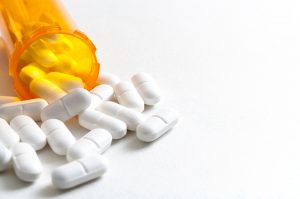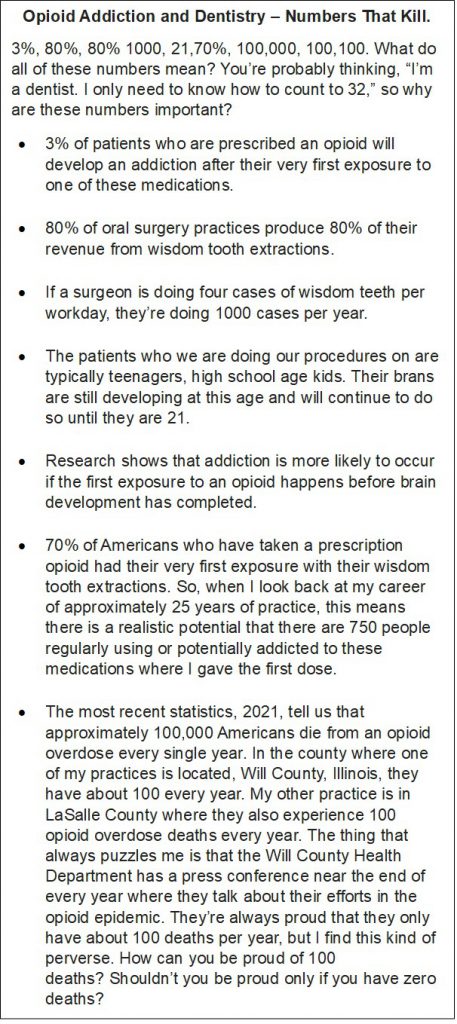In my years of practice and teaching residents at one of the busiest residency programs in the country, I have encountered over 20 doctors who have struggled with opioid addiction. Among them, ten faced license suspensions or revocations, and two served time in prison. Most tragically, two have succumbed to lethal overdoses.
In my opinion, it’s crucial to bear in mind that, apart from our career paths, there is fundamentally no difference between our patients and ourselves.
We should be aware of the challenges our colleagues are confronting and, perhaps, extend a bit of kindness as well.
Why does this hit home?
After dental school, I completed a General Practice Residency (GPR). Right from the beginning, I witnessed ER patients in distress due to dental pain, yet I couldn’t pinpoint the cause. We had a small clinic adjacent to the ER, where we would take patients for x-rays and thorough examinations, but the source of their pain remained elusive.
Simultaneously, ER doctors would urge us not to let the patients suffer and provide guidance on what to prescribe, typically suggesting Tylenol #3, Vicodin, or similar medications.
Following my GPR, I embarked on my oral surgery residency, and a similar scenario unfolded. Each morning, we would handle emergency extractions for 60 to 70 patients, and they were understandably discontented. They were in pain, and I found myself uncertain about the next steps after removing the problematic tooth.
I call it the idiot, idiot, idiot approach.
As the most junior inexperienced guy there, I would ask the idiot above me what to do. He guided me towards what to prescribe, which he learned from the idiot above him.
There was no science or research behind it. It was simply just doing what has always been done.
My early experience in private practice was similar. The first indication that maybe something wasn’t right happened after many years of practice. I remember the patient well. It was someone who I had seen for multiple procedures from early teenage years into early adulthood (the first one being an expose and bond at about 12 years old).
Over the next few years, there was another expose and bond, the wisdom teeth and then there was something else which I no longer remember. What I do remember is after about 10 years after seeing her for the first time, I started seeing local newspaper articles about her arrests for different things that always included possession charges.
At some point, I had the realization that I was probably the guy who wrote her first prescription for a strong pain medication with that very first expose and bond many years earlier.
I think the event that really cemented it home was a couple years after that, approximately 2015. I saw a patient for a third or fourth postop over about two weeks for a very simple procedure. They complained of increasing pain, yet the surgical site looked like it was healing very well and there was no evidence of any issues. The next morning one of my team members came into work and was setting up for the day. “Funny story about that last patient from yesterday. I went to Walgreen’s on my way home, pulled into the parking lot, and she was handing over a bag from the pharmacy to somebody who was handing her cash.”
I realized that the postop pain was probably not true. It was probably a way to get a prescription for the “resale market.”
I made the decision that I was going to alter my practice and avoid prescribing opioids. I started out with what I called the “two Advil and rub some dirt in it method.” After reading some research reports showing that NSAIDS are better than opioids for dental pain, I was advising people to take two over-the-counter ibuprofen every six hours. Fail. No, BIG FAIL.
It wasn’t adequate. I needed to do something else in order to manage the inflammation, so they didn’t have pain in the first place. I spent a lot of time developing my technique in order to really determine what was going on to help my patients have a comfortable experience. We know that dental pain is somatic pain and involves inflammation of the tooth, the bone and the surrounding soft tissues.
Very good research definitively shows that NSAIDs are superior to opioids for managing this type of pain. It has also been shown that NSAIDs will actually have their pain relief effect potentiated by acetaminophen.
When we look at the characteristics of NSAIDs, specifically ibuprofen, we see that the maximum pain relief turns out to be only 400 mg. The maximum anti-inflammatory dose is 600 mg, and 800 mg will not give a better effect. The ideal dosing interval turns out to be six hours. If doses are taken more than six hours apart, the blood level will drop too low to have an adequate effect so the ideal dosage for ibuprofen 600 mg every six hours.
We also want them taking over-the-counter acetaminophen at the same time as they are taking the ibuprofen. It is very commonly taught to take ibuprofen and acetaminophen at different times, every three hours so you’re not waiting too long in between doses.
This turns out to be the best strategy when you’re dealing with a fever, but when we’re dealing with pain we want the potentiation, we want them to take the medications at the same time.
Looking at a package of OTC acetaminophen, it will tell you that you don’t want to take more than six in the 24-hour period which turns out to be 3000 mg. However, that is not accurate. The real maximum dose per day is 4000 mg. The dosing regimen that that I am using is 600 mg of ibuprofen and two OTC acetaminophen every six hours around the clock for four days and then every six hours as needed after that.
I have also changed my sedation technique. Instead of fentanyl, I use altered dosages of other medications in order to achieve the same results without exposing my patients to the opioid. Then, there is some preop stuff that we start before the procedure. Tissue conditioning to get the gingiva as healthy as possible, followed by continued tissue conditioning and rinsing for seven days postop.
I’ve incorporated long-acting, slow release, local in order to reduce the sensation in the area slightly in order to reduce the patient’s discomfort. The results? It is very uncommon for my patients to require anything additional. We find that most are back to their normal routine within a couple of days. And I find that my patient’s parents are very pleased with not having their children exposed to anything that’s potentially addictive.
It’s time to do our part to stop the opioid crisis.
To remove the use of opioids, I’ve changed my practice and developed a new technique. But will everything that I’ve done and continue to do, change the world? And the answer is absolutely NOT. How about you as another dental provider who can also play a part in changing how you are practicing. Can you change the world? And the simple answer is absolutely, NOT.
The million-dollar question is can WE change the world?
If a large number of providers change their status quo and put an effort into preventing that first prescription for an opioid in opioid-naïve teenagers around the country, will that make a change? And the answer is ABSOLUTELY. I invite you to please join my mission. Look at how you practice and what you’re doing for your patients.
Always do your best to prescribe what is needed and best for them, not necessarily what has always been done.
ABOUT THE AUTHOR
Dr. James Babiuk, also known as TheWisdomToothDoc (https://wisdomteethjoliet.com), is the founder of The Centre for Oral Surgery in Joliet, Illinois, an international speaker and the author of “What Every Parent of an Adolescent Needs to Know About Opioids.” A graduate of Northwestern University, Dr. Babiuk taught oral surgery and outpatient anesthesia to residents in training at Cook County/Stroger Hospital in Chicago and has been in practice for over 25 years with 29-plus years of anesthesia experience and well over 234,737 teeth extractions. He is known for holistic oral surgery, focusing on all aspects of the patient and going above and beyond to exceed their unique needs.
FEATURED IMAGE CREDIT: Victor Moussa/Shutterstock.com.














